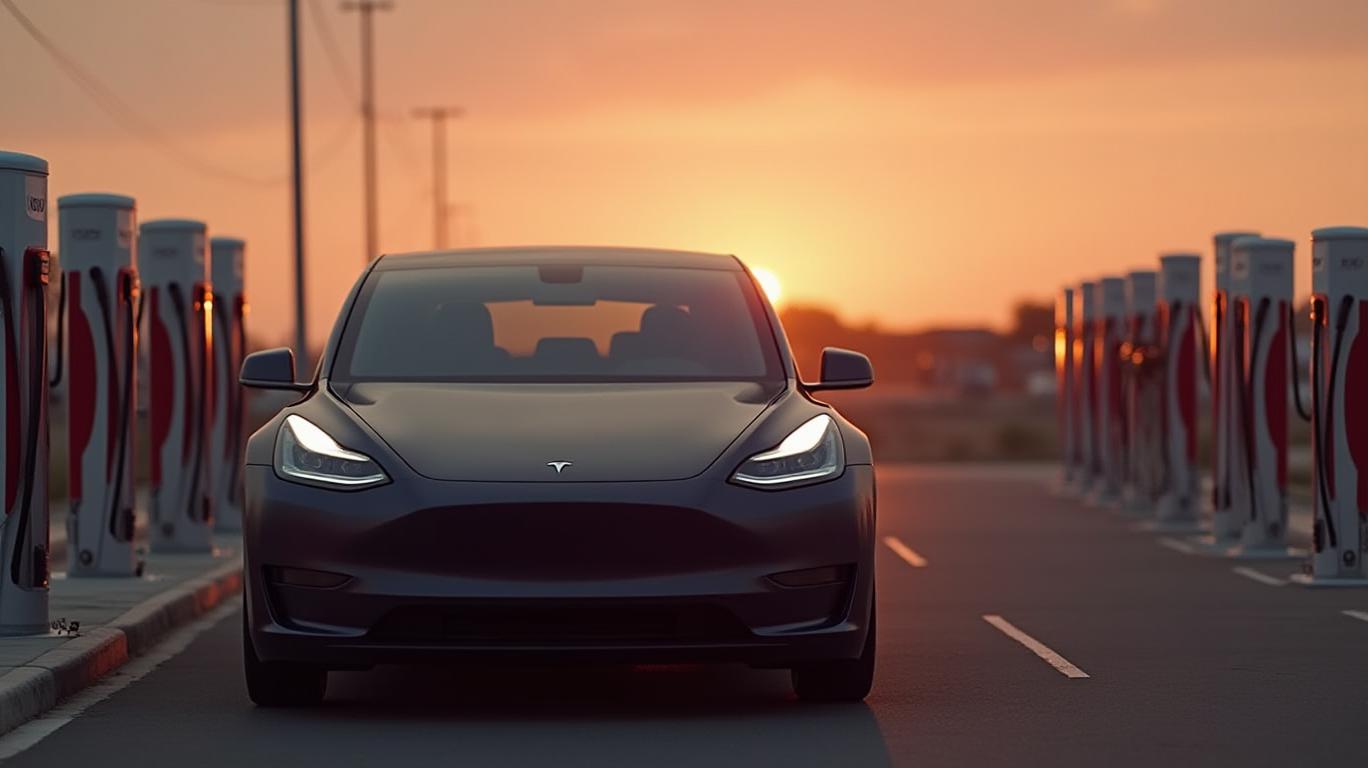Auto & Transport Roundup: Navigating Tariffs and EV Turbulence in 2025
The auto and transport sectors entered 2025 amid a clash of forces: surging electric vehicle (EV) competition, protectionist trade policies, and supply chain fragility. While
(GM) and Ford have seized momentum, Tesla’s dominance is fading, and Stellantis grapples with headwinds. Regulatory shifts and geopolitical tensions are reshaping markets, demanding agility from investors.
EV Market Dynamics: A Shift in Power
The U.S. EV market is undergoing a seismic shift. Tesla, once the undisputed leader, saw its Q1 2025 sales drop 9% year-over-year (YoY) to 128,000 units, with market share collapsing to 3% from 5% in early 2023. Analysts attribute this to a lack of product innovation and the surge of rivals like GM.
Tesla’s stock, which peaked at $300 in early 2023, now trades below $180, reflecting investor skepticism about its ability to sustain growth. Its Model Y relaunch in Q1 2025 has yet to reverse the slide.
GM, meanwhile, is on a roll. EV sales nearly doubled YoY to 30,000 units, driven by Chevrolet’s Equinox and Blazer EVs. Total U.S. sales rose 17% to 693,000 vehicles, with pickup trucks hitting a 17-year high. This breadth of success—spanning trucks, SUVs, and EVs—has made GM the sector’s clear leader.
Ford’s performance was mixed. While F-Series trucks surged 24.5% to 190,000 units, car sales collapsed 31%, and SUV sales fell 16.7%. Electrified vehicles, however, grew 25.5%, suggesting Ford is slowly pivoting to meet demand.
Stellantis, the European giant, faces tougher terrain. U.S. sales fell 12% to 293,000 units, though Fiat’s EV500e and Jeep’s retail momentum offer glimmers of hope.
Regulatory and Trade Challenges
The auto industry’s next hurdle is the U.S. trade regime. New tariffs—including 25% on Mexican imports and 10% on Chinese goods—are set to reshape manufacturing. Over 90% of Mexican auto exports flow to the U.S., so Ford and Volkswagen may face tough choices: relocate production or absorb costs.
The Inflation Reduction Act (IRA) complicates matters further. Its EV tax credit requirements, which mandate U.S.-sourced batteries, have reduced eligible models from 45 to fewer than 30. Tesla’s Model 3 and Ford’s F-150 Lightning were initially excluded, though leasing programs temporarily mitigated impacts.
Global disparities persist. China dominates with 60% of global EV sales, while the U.S. lags at 7.5%—a gap widened by supply chain bottlenecks and delayed charging infrastructure.
The EU’s Digital Operational Resilience Act (DORA) adds another layer, mandating cybersecurity upgrades for automotive software. Meanwhile, its 2035 ICE vehicle ban accelerates EV adoption but risks market fragmentation as the U.S. scales back federal incentives.
Transport Sector Strains
Logistics firms face their own crises. U.S. ports handled 25.5 million TEUs in 2024, nearing 2021 records, as retailers frontloaded imports ahead of tariffs. The FMCSA’s Clearinghouse-II rule has revoked 67,000 carrier licenses since 2023, shrinking trucking capacity and pushing spot rates higher.
The NMFTA’s July 2025 shift to density-based LTL classifications will force shippers to adopt dimensioning technology, risking misclassification disputes. USPS’s 3.2% rate hike and UPS’s strategic pivot to abandon 50% of Amazon business by 2026 highlight a parcel market in flux.
Stock Performance: Winners and Losers
- GM (GM): Strongest position. Its EV growth, truck dominance, and diversified portfolio justify a bullish stance.
- Tesla (TSLA): At risk of becoming a value trap unless innovation accelerates. The Model Y relaunch’s impact will be critical.
- Ford (F): Mixed signals. Truck resilience contrasts with declining non-pickup segments; its stock may remain range-bound.
- Stellantis (STLA): Vulnerable to trade tariffs and supply chain disruptions. Success hinges on EV launches like the Fiat 500e.
Conclusion: Adapt or Be Overtaken
The auto sector’s 2025 landscape is one of fragmentation and urgency. GM’s leadership underscores the power of a balanced portfolio—trucks, affordable SUVs, and EVs—while Tesla’s decline highlights the perils of complacency. Tariffs and supply chain risks demand localized manufacturing and partnerships (e.g., GM’s Honda alliance).
Investors should favor companies with domestic production flexibility, robust EV pipelines, and exposure to high-growth regions like Southeast Asia. Stellantis and Ford must prove they can pivot faster than their balance sheets suggest. Tesla, meanwhile, faces a stark choice: innovate or decline further.
The data is clear: EVs now account for 7.5% of U.S. auto sales, up from 7% in 2024—but this growth is uneven. With global EV sales surging in China and Europe, the U.S. risks falling behind unless infrastructure and incentives catch up. For now, the road ahead is bumpy, but the winners are those who master the detours.

Comments
No comments yet